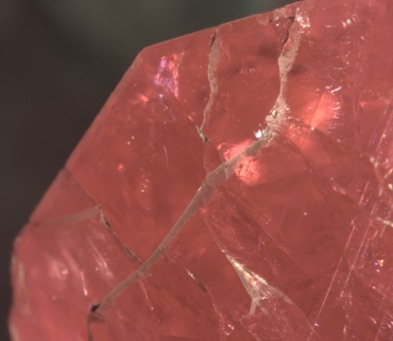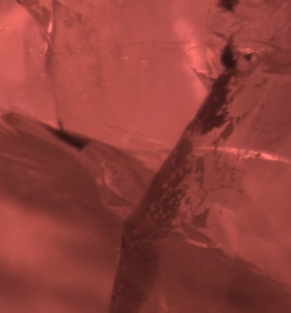PUBLICATIONS
An unusual filled ruby, likely oiled
A 12.12 ct rectangular red stone with cut edges (Figure 1) was submitted to the LFG. The refractive index, density, raman spectrum and colour pointed to its being a ruby. It fluoresces medium to strong red under long ultraviolet rays, and more lightly under short waves. Under high magnification, it shows fairly dense accumulations of long needles, some of which are a little flat, mostly iridescent. (Figure 2). Many twinning flakes run through the gem (Figure 3). An EDXRF carried out using a Rigaku NexCG secondary target spectrometer indicates, in addition to the expected aluminium, oxygen and chromium, the presence of approximately 2420 ppmw vanadium, a little iron (1760 ppmw) and gallium (1030 ppmw), with traces of potassium and calcium. There is no indication of thermal treatment, and both the inclusions and chemistry are compatible with Myanmar origin.

Figure 1. This 12.12-ct red stone shows characteristics typically associated with a natural ruby.

Figure 2. Tight accumulation of iridescent needles x 50

Figure 3. Contrasting twinning flakes, often observed in Burmese rubies x 60

Figure 4. Visible filling in fractures near the surface x 40
More interestingly, multiple fractures can be seen, the smallest following the twinning flakes. Closer examination of their outcrop on the surface shows a material present in the fractures, which has left white marks in the fracture near the surface at certain points.

Figure 5. Contrasting fracture filling x 40
Looking further through the fractures, there are flat bubbles, networks of slots as in dried mud, or a form of dendritic appearance (Figure 5 and 6).

Figure 6. Fracture with dendritic appearance x 36

The same type of pattern can be seen when drying oil in emeralds (Hänni, 1988 & 1996).
Under the heat of the fibre optic during observation, droplets formed at the surface of the cracks. This indicates that the material is liquid or that its melting point is just below the fibre optic temperature. This may be oil or wax.
Observed in DiamondView®, the material inside the fractures is revealed by luminescence under very short wavelength radiation. (Figure 7).
Infra-red absorption confirms the presence of an organic material in fractures. (Figure 8). Oil peaks, at approximately 2852, 2925 and 2955 cm-1, are at almost identical positions as those observed in impregnated emeralds. (Johnson et al., 1999; Zecchini & Maitrallet, 1998). In addition, there is a large figure between approximately 2500 and 3500 cm-1, which is due to the orange product, a material resembling the rust found in open cracks of many gems, including corundum. They are accompanied by fine absorptions of around 3600 – 3700 cm-1, as is often the case, attributed to minerals in the kaolinite group. (Beran & Rossmann, 2006). The 2463 cm-1 strip is produced by CO2.

Therefore, based on the observations under magnification and infra-red absorption, we concluded that this ruby showed “moderate modifications by treatment of transparency (oil)”. Although rubies with glass-filled cavities are common on the market today, oiled corundum is rarer. What is unusual for this oiled ruby is that it is of large size and hails from Myanmar.
A publication of:
Alexandre Droux (LFG) Emmanuel Fritsch
References:
Beran A., Rossman G.R. (2006). OH in naturally occurring corundum.
European Journal of Mineralogy, Vol. 18, pp. 441–447.
Hänni H.(1988). Gemmology, an oil well in your garden ? Schweizer Uhren & Schmuck Journal, n°3.
Hänni H.A., Keifert L., Chalain J.-P. (1996). How to identify fillings in emeralds using Raman spectroscopy. Jewellery News Asia, No. 145, pp. 154–156.
Johnson, M. L., Elen, S., & Muhlmeister, S. (1999). On the identification of various emeralds filling substances. Gems & Gemology, 35(2), 82-107.
Zecchini P., Maitrallet P. (1998). Que peut apporter la spectrographie infrarouge dans l’étude des émeraudes ? In D. Giard, Ed., L’émeraude: Connaissances Actuelles et Prospectives.
Association Française de Gemmologie, Paris, pp. 81–96.Alexandre Droux, Responsable pierres de couleur, LFG
Emmanuel Fritsch, professeur de physique, Université de Nantes



